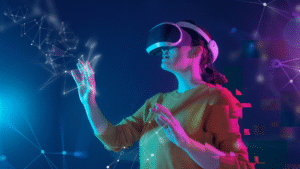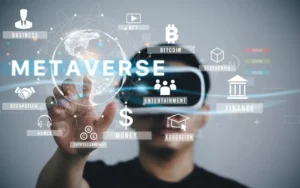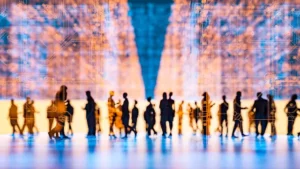Imagine stepping into a world where your morning coffee chat happens in a virtual Parisian café, your work meeting takes place on a digital beach, and your evening workout feels like a trek through a Martian landscape. This isn’t science fiction—it’s the metaverse, and by 2030, it’s poised to redefine how we live, work, and play. As someone who’s been fascinated by tech’s evolution (and maybe spent too many hours in virtual worlds myself), I’m here to guide you through what the metaverse will look like in 2030. From immersive education to virtual economies, this article dives deep into the trends, challenges, and opportunities awaiting us, backed by research and a sprinkle of real-world stories to make it all feel human.
What Is the Metaverse, Really?
The metaverse is a network of interconnected virtual spaces where people interact through avatars, blending the physical and digital worlds. Think of it as the internet’s 3D evolution, powered by virtual reality (VR), augmented reality (AR), and artificial intelligence (AI). By 2030, it’s expected to be a seamless, immersive experience, not just a clunky headset game.
Why It’s More Than Just Gaming
While gaming platforms like Roblox and Fortnite laid the groundwork, the metaverse in 2030 will extend far beyond entertainment. It’s a space for work, education, socializing, and even healthcare, merging digital and physical realities in ways we’re only beginning to grasp.
The Tech Driving the Metaverse in 2030
By 2030, the metaverse will lean on cutting-edge technologies that make it feel as real as your morning commute—minus the traffic. Advancements in hardware and software are the backbone of this transformation, and they’re evolving faster than my attempts to keep up with the latest VR headsets.
Virtual Reality (VR) and Augmented Reality (AR)
VR headsets and AR glasses will be lighter, wireless, and as comfortable as your favorite sunglasses. Expect 8K resolution displays and built-in sensors for natural hand tracking, making clunky controllers obsolete.
Artificial Intelligence (AI)
AI will power lifelike avatars and dynamic environments that adapt to your preferences. Imagine an AI-driven virtual mentor guiding you through a coding bootcamp or a digital therapist offering real-time support.
Blockchain and Digital Ownership
Blockchain will secure virtual assets like NFTs (non-fungible tokens), ensuring you truly own that virtual beachfront property or rare digital art piece. Decentralized platforms will make transactions transparent and secure.
5G and Beyond
Ultra-fast 5G and emerging 6G networks will eliminate lag, making real-time interactions in the metaverse as smooth as a face-to-face chat. This is critical for global collaboration and massive virtual events.
Key Technologies Driving the Metaverse in 2030
| Technology | Role in Metaverse | Example Use Case |
|---|---|---|
| VR/AR | Immersive interfaces | Virtual classrooms, AR-enhanced shopping |
| AI | Personalized experiences | AI tutors, dynamic NPCs |
| Blockchain | Secure digital ownership | NFT-based virtual real estate |
| 5G/6G | Seamless connectivity | Global virtual concerts |
How the Metaverse Will Transform Daily Life
The metaverse isn’t just a tech toy—it’s a lifestyle shift. By 2030, it’ll touch nearly every aspect of our lives, from how we learn to how we shop. Let’s explore the key areas where it’ll make the biggest splash.
Education: Learning in a Virtual World
Picture a history class where you walk through ancient Rome or a biology lab where you dissect a virtual frog without the smell. The metaverse will make education immersive and accessible, especially for remote learners.
Benefits for Students and Teachers
Students will enjoy personalized learning paths, while teachers can use VR to simulate real-world scenarios. For example, medical students could practice surgeries in a risk-free environment, boosting confidence and skills.
Challenges in Education
High costs and access gaps could limit adoption. Schools in underserved areas may struggle to afford VR headsets or high-speed internet, risking a digital divide.
Pros and Cons of Metaverse in Education
- Pros: Immersive learning, global access, personalized experiences
- Cons: High setup costs, potential for unequal access, technical glitches
Work: The Virtual Office Revolution
Remember the Zoom fatigue of the early 2020s? By 2030, virtual offices in the metaverse will replace 2D video calls with 3D workspaces. I once joined a virtual meeting in a prototype metaverse platform, and it felt like catching up with colleagues in a real office—minus the bad coffee.
Remote Work Redefined
Teams will collaborate in shared virtual spaces, designing products or brainstorming in environments that spark creativity. Think virtual whiteboards that feel like drawing on a real wall.
The Gig Economy in the Metaverse
Freelancers will offer services like virtual event planning or avatar design, creating new income streams. Platforms like Decentraland are already hinting at this future.
Social Connections: Friends in a Digital World
The metaverse will make distance irrelevant. You’ll attend virtual concerts with friends across the globe or host a birthday party in a digital penthouse. My cousin in Tokyo and I once tried a VR hangout—it was like sharing a couch despite being 6,000 miles apart.
Building Communities
Virtual spaces will foster niche communities, from book clubs to fitness groups, where avatars make interactions feel personal. But moderation will be key to prevent toxic behavior.
The Risk of Isolation
While the metaverse connects us, over-reliance could lead to social isolation. Striking a balance between virtual and real-world interactions will be crucial.
Healthcare: Virtual Care, Real Impact
The metaverse will revolutionize healthcare by enabling virtual therapy, remote surgeries, and even VR-based physical rehab. Imagine recovering from an injury by “walking” through a virtual forest with a therapist guiding you.
Mental Health Support
AI-driven avatars could provide 24/7 mental health support, making therapy more accessible. But ethical concerns, like data privacy, will need addressing.
Entertainment and Commerce: Shop and Play in 3D
From virtual concerts to NFT marketplaces, the metaverse will redefine fun and shopping. Brands like Nike are already selling virtual sneakers—by 2030, your avatar’s wardrobe might rival your real one.
Virtual Economies
You’ll earn and spend digital currencies in the metaverse, buying everything from virtual land to exclusive event tickets. Blockchain ensures these transactions are secure.
Comparison: Metaverse vs. Traditional Internet
| Feature | Metaverse (2030) | Traditional Internet (2025) |
|---|---|---|
| Interaction Style | 3D immersive, avatar-based | 2D screen-based |
| Accessibility | VR/AR devices required | Any device with a browser |
| Engagement Level | High (sensory immersion) | Moderate (visual/audio) |
| Economic Opportunities | Virtual goods, NFTs | E-commerce, ads |
Challenges Facing the Metaverse by 2030
The metaverse isn’t all rosy. As exciting as it sounds, it comes with hurdles that could slow its adoption or create new problems. Let’s dive into the big ones.
Privacy and Security Concerns
Your avatar’s every move could be tracked, raising questions about data privacy. Who owns your virtual behavior data? Without robust regulations, companies might exploit it.
Ethical Dilemmas
From deepfake avatars to virtual harassment, the metaverse could amplify ethical issues. Clear guidelines and AI moderation will be essential to keep spaces safe.
Accessibility and Equity
Not everyone can afford a $500 VR headset or a 5G connection. By 2030, bridging this gap will be critical to avoid excluding marginalized communities.
Health and Addiction Risks
Spending hours in VR could strain eyes or lead to addiction, especially for younger users. My nephew once lost track of time in a VR game—multiply that by millions, and it’s a public health concern.
The Economic Impact of the Metaverse
By 2030, the metaverse could be a multi-trillion-dollar industry, creating jobs and new markets. From virtual real estate to digital fashion, the opportunities are vast—but so are the risks.
Job Creation
New roles like metaverse architects, avatar designers, and virtual event planners will emerge. I know a graphic designer who’s already pivoting to creating 3D assets for VR platforms.
Investment Opportunities
Investors are pouring billions into metaverse startups. By 2030, expect venture capital to focus on AI-driven platforms and blockchain solutions.
Economic Projections for the Metaverse
| Year | Estimated Market Size | Key Growth Drivers |
|---|---|---|
| 2025 | $800 billion | Gaming, early adoption |
| 2030 | $2–5 trillion | VR/AR, AI, blockchain |
How to Prepare for the Metaverse Future
Ready to dive into the metaverse? Whether you’re a student, professional, or curious explorer, here’s how to get started.
Best Tools for Accessing the Metaverse
- VR Headsets: Meta Quest 4, Apple Vision Pro (rumored for 2030). Start with budget-friendly options like Quest 3.
- AR Glasses: Lightweight models from Google or Snap for everyday use.
- Platforms: Explore Decentraland, Roblox, or Horizon Worlds for early metaverse experiences.
Skills to Learn
- 3D Modeling: Tools like Blender for creating virtual assets.
- Blockchain Basics: Understand NFTs and decentralized platforms.
- AI Programming: Python and machine learning for building smart avatars.
Where to Get Started
- Free Resources: Try platforms like VRChat or Roblox for low-cost entry.
- Courses: Platforms like Coursera offer VR/AR and blockchain courses.
- Communities: Join Discord or Reddit groups for metaverse enthusiasts to stay updated.
People Also Ask (PAA)
What will the metaverse look like in 2030?
By 2030, the metaverse will be a seamless blend of VR, AR, and AI, offering immersive spaces for work, education, and socializing. Expect lifelike avatars, secure digital economies, and widespread adoption across industries.
Is the metaverse safe to use?
Safety depends on robust privacy laws and moderation. While blockchain ensures secure transactions, risks like data tracking and virtual harassment require strong ethical frameworks.
How can I invest in the metaverse?
Invest in VR/AR hardware companies, blockchain platforms, or metaverse startups. ETFs focused on immersive tech are also a safer bet for beginners.
Will the metaverse replace the internet?
It won’t replace the internet but evolve it into a 3D, immersive version. Think of it as the internet’s next chapter, not a full replacement.
FAQ Section
Q: How will the metaverse impact education by 2030?
A: It’ll offer immersive learning, like virtual labs or global classrooms, but costs and access gaps could limit its reach.
Q: Can I make money in the metaverse?
A: Yes, through virtual real estate, NFT creation, or services like event planning. Blockchain ensures secure transactions.
Q: Is the metaverse bad for mental health?
A: Overuse could lead to addiction or isolation, but it also offers mental health support via virtual therapy. Balance is key.
Q: What devices do I need for the metaverse?
A: A VR headset (e.g., Meta Quest) or AR glasses, plus a strong internet connection. Budget options are increasingly available.
Q: How do I stay safe in the metaverse?
A: Use secure platforms, protect personal data, and support regulations for ethical moderation. Awareness is your best defense.
The Road Ahead: A Balanced Future
The metaverse in 2030 will be a game-changer, blending the best of tech with human creativity. But it’s not a utopia. Privacy concerns, accessibility gaps, and health risks demand careful navigation. As we step into this brave new world, let’s embrace its potential while advocating for a safe, inclusive space. Whether you’re designing avatars, teaching in VR, or just hanging out in a digital café, the metaverse is yours to shape. So, grab a headset, explore a platform, and let’s meet in the virtual world—just don’t forget to log off and enjoy some real-world sunshine too.







